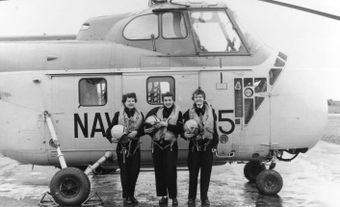During the Second World War, a large naval repair base was established at Shelburne, Nova Scotia, where many Allied ships were refitted and repaired following their work maintaining convoy and antisubmarine surveillance in the Atlantic. During the Cold War, HMCS (later CFS) Shelburne played an important role in antisubmarine warfare, part of the SOSUS/IUSS network of passive sonar stations that identified and tracked Soviet submarines. CFS Shelburne was decommissioned in 1995.

Second World War
HMCS Shelburne was located on the eastern shore of Shelburne Harbour at the mouth of the Roseway River, south of the town of Shelburne in the community of Sandy Point. Established in 1941, it was the largest ship-repair establishment manned entirely by naval personnel. At its peak, more than 5,000 military personnel worked there.
The site’s primary work was in refitting and reconditioning fighting ships; this included installing new and evolving secret equipment to meet the changing demands of combat conditions during the Battle of the Atlantic (1939–45). For security purposes, a submarine net was laid outside the harbour entrance. (See also U-boat Operations.) A Canadian National Railway (CNR) spur line off CNR’s Yarmouth and Halifax main line was also constructed to serve the site.
By 1942, the Royal Canadian Air Force (RCAF) had also constructed a seaplane patrol training squadron south of HMCS Shelburne facilities named RCAF Station Shelburne. By 1944, the RCN took over the station, which became part of HMCS Shelburne.
Hostilities in Europe and the Atlantic Ocean ceased on 7 May 1945 with the unconditional surrender of German forces. (See also VE-Day.) On 13 May 1945, German submarine U-889 formally surrendered to the Royal Canadian Navy (RCN) at HMCSShelburne.
By November 1945, the site was full of warships at the end of their service. HMCS Shelburne closed in 1946.

Cold War and SOSUS/IUSS
HMCS Shelburne was reactivated in April 1955 during the Cold War as an “oceanographic research station,” operated jointly by the RCN and the United States Navy (USN). There were nine such stations on the Atlantic coast, part of the secret Sound Surveillance System (SOSUS), a network of passive sonar stations used to identify and track Soviet submarines. It was renamed the Integrated Undersea Sound Surveillance System (IUSS) in 1985. Using fixed, mobile and deployable acoustic devices, SOSUS/IUSS provided vital tactical information to antisubmarine warfare (ASW) forces and was a primary means for detecting both conventional and nuclear submarines.
When HMCS Shelburne first began operating as part of SOSUS in 1955, it was staffed by personnel from both the RCN and USN. The commanding officer of HMCS Shelburne became the officer-in-charge of the station, which the USN referred to as an oceanographic research naval facility (NAVFAC). This made Shelburne the only NAVFAC not under the direct control of the USN. Of the Shelburne NAVFAC’s original complement, five were women — all members of the RCN. This predated the assignment of women to USN NAVFACs by 17 years.
Did you know?
During much of the Cold War, female members of the navy were commonly referred to as “Wrens,” a nickname that originated in the Second World War. Although limited at first to onshore trades and occupations, women began serving on ships in the 1970s in the naval reserve and in the 1980s in the regular navy. Beginning in 1989, women could serve in all military trades and occupations except submarine service, which opened to women in 2001. (See Canadian Women in the Cold War Navy.)
On 1 November 1959, the RCN assumed all manning responsibilities for the shore station. Later, with the integration of the RCN into the unified Canadian Armed Forces (CAF) in 1968, HMCS Shelburne was renamed Canadian Forces Station (CFS) Shelburne.
CFS Shelburne continued its important shore station role until closing in August 1994. The site was decommissioned in March 1995, when the federal government transferred the lands to the Government of Nova Scotia, which in turn created the Shelburne Park Development Agency.

 Share on Facebook
Share on Facebook Share on X
Share on X Share by Email
Share by Email Share on Google Classroom
Share on Google Classroom



